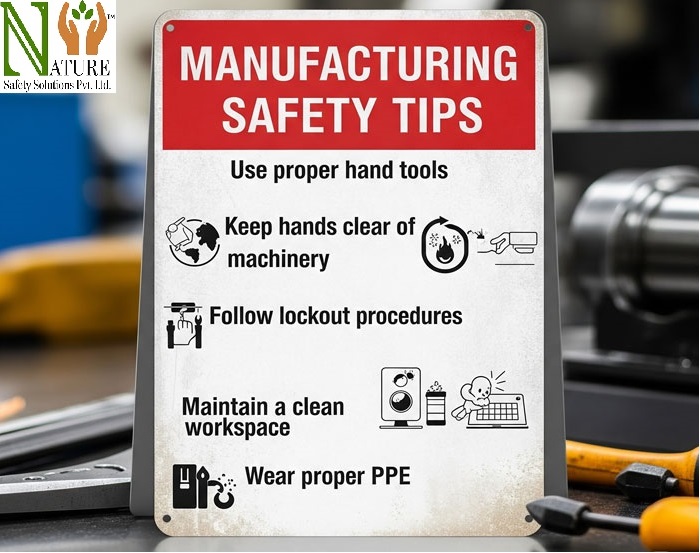In any manufacturing environment, safety must be a top priority. Every shift presents new challenges and potential hazards, from operating heavy machinery to handling chemicals, electrical tools, or hazardous materials.
Creating a safe workplace isn’t only about compliance with rules and regulations, it’s about protecting lives and fostering a culture of responsibility. This article explores ten daily safety tips that can make a meaningful difference in your work environment.

1. Conduct a Pre-Shift Safety Inspection
Starting your day with a thorough inspection of your workstation is an essential habit. Before beginning your tasks:
- Check for any tripping hazards, such as loose wires or tools left on the floor.
- Ensure machines are working properly with no visible damage.
- Inspect safety signs to make sure they are legible and visible.
- Look for any unusual smells, leaks, or noises that could indicate malfunction.
By making this a routine part of your shift, you help identify hazards before they become accidents.
Why it matters: Early detection of issues reduces the risk of injuries and equipment damage, which can save lives and reduce costs.
2. Always Wear Personal Protective Equipment (PPE)
PPE is your first line of defense against physical, chemical, and biological hazards. Depending on your tasks, this may include:
- Safety goggles to protect against flying debris
- Gloves to shield hands from heat, cuts, or chemicals
- Steel-toed boots to guard feet from heavy objects
- Respirators for protection from dust or fumes
- High-visibility vests to increase your visibility in low-light areas
Why it matters: PPE is designed to reduce the severity of injuries or prevent them entirely. Wearing the correct PPE and ensuring it fits well is critical to keeping yourself safe.
3. Follow Lockout/Tagout (LOTO) Procedures
LOTO procedures are used to ensure that machines are powered off and remain off while maintenance is performed. Every machine with moving parts or electrical power should be properly locked and tagged out before any servicing begins.
Why it matters: Without proper LOTO protocols, a machine can restart unexpectedly, causing severe injury or even death to the technician working on it.
Tip: Never assume that a machine is safe. Follow the procedure yourself or double-check if it’s already in place.
4. Keep Your Workspace Clean and Tidy
Housekeeping in the workplace is often overlooked but plays a critical role in maintaining safety.
- Sweep and mop spills immediately
- Keep aisles, stairways, and emergency exits clear
- Store tools and equipment properly when not in use
- Dispose of waste in designated bins
Why it matters: A cluttered environment increases the risk of slips, trips, and falls—which are among the most common workplace injuries.
5. Stay Alert Around Machinery and Vehicles
Stay vigilant when working near or operating machinery such as forklifts, conveyor belts, or cranes.
- Don’t assume the operator sees you
- Avoid walking in blind spots
- Make eye contact before passing
- Never distract someone operating machinery
Why it matters: Awareness can prevent collisions, crush injuries, and other serious accidents.
6. Use Proper Lifting Techniques
Many workplace injuries are due to improper lifting. Here’s how to lift correctly:
- Bend at your knees, not your back
- Keep the object close to your body
- Use your legs to lift
- Avoid twisting while lifting
- Use mechanical aids (like pallet jacks or forklifts) or ask for help if the load is too heavy.
Why it matters: Improper lifting can cause back strains, hernias, or long-term musculoskeletal issues.
7. Report Unsafe Conditions Immediately
Whether it’s a broken ladder, a loose railing, or a chemical spill, don’t ignore it. Report all unsafe conditions to your supervisor or the safety officer.
Why it matters: Prompt reporting ensures quick resolution, preventing minor hazards from becoming serious threats.
Tip: Don’t wait for someone else to fix it—take ownership.
8. Take Regular Breaks to Prevent Fatigue
Physical and mental fatigue can cause lapses in concentration, leading to errors or injuries. Breaks are not just a legal requirement—they’re essential for staying sharp.
- Take short, scheduled breaks to stretch and hydrate
- Avoid excessive caffeine or skipping meals
- Use breaks to mentally recharge
Why it matters: Alert workers are better equipped to respond quickly to dangerous situations.
9. Never Disable Safety Features
Modern equipment often includes emergency stops, sensors, and automatic shutoffs. These features are there for a reason.
- Never remove safety guards
- Don’t override alarms or warning systems
- Notify maintenance if a feature is malfunctioning
Why it matters: Disabling safety mechanisms compromises not just your safety but everyone else’s too.
10. Keep Learning Through Safety Training
Ongoing training is critical in staying updated with the latest safety procedures.
- Attend all mandatory training sessions
- Participate in toolbox talks and briefings
- Learn from real-life accident case studies
- Ask questions when in doubt
Why it matters: A knowledgeable worker is a safer worker. Training ensures everyone on the floor is prepared and aware of best practices.
Also read:-
- Water Conservation Tips for Offices and Factories
- Top 10 Reasons to Upgrade to EHS Safety Audit Tools
- Why Environment, Health & Safety Matters More Than Ever
- The Role of EHS Professionals in a Post-Pandemic World
- Benefits of Tree Plantation Drives at Workplaces
- Workplace Safety: Building a Culture of Protection and Prevention

Pingback: The Hidden Effects of Climate Change on Everyday Life -